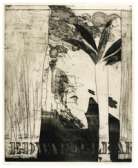
Edward Lear

Edward Lear
Signed Print
David Hockney
£2,700-£4,050
$5,500-$8,500 Value Indicator
$5,000-$7,500 Value Indicator
¥26,000-¥40,000 Value Indicator
€3,100-€4,700 Value Indicator
$28,000-$45,000 Value Indicator
¥540,000-¥800,000 Value Indicator
$3,650-$5,500 Value Indicator
There aren't enough data points on this work for a comprehensive result. Please speak to a specialist by making an enquiry.
78 x 65cm, Edition of 50, Intaglio
Auction Results

Track auction value trend
Meaning & Analysis
This signed print by British artist David Hockney was issued in an edition of 50 in 1964. It depicts the English artist, illustrator, musician, author and poet, Edward Lear, and is characteristic of Hockney’s gestural approach to etching during the 1960s.
This signed print by British artist David Hockney was issued in an edition of 50 in 1964. Much like Hockney, Lear became well-known for his paintings depicting travel destinations, such as Greece and Egypt. Like Hockney, who in 1964 moved from cold and grey post-war London to California, setting up his home and studio in Santa Monica, Lear adopted Italy as his home in the 1870s. Settling in San Remo in the province of Liguria, Lear – like Hockney – also gravitated towards the coast. An impression of warmer climes permeates this semi-abstract print, with Hockney sure to include impressions of hills, clouds and a palm tree – one of his recurring subjects – in the foreground. Reminiscent of Hockney’s Influences series, the print features the name of the artist, stencilled in bold, dark letters, at the bottom of its composition. In a sense, Hockney here constructs a rather didactic tribute to a figure who guided his early artistic production. Echoing another similar piece in the series, The Student (1973), in which Hockney depicts himself standing next to a bust of one of his greatest inspirations – artist Pablo Picasso – Edward Lear helps to map out the art historical basis to the artist’s wider œuvre at a time when he was finding his feet, a recent graduate of London’s Royal College of Art.